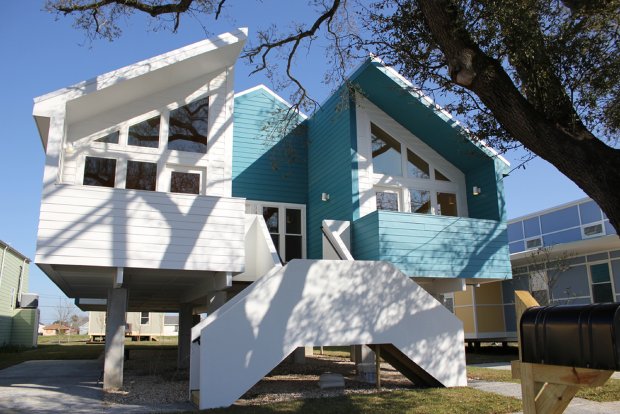Katrina Victims Live Out Hollywood Eco-Agenda
By Byron York
WashingtonExaminer.com

NEW ORLEANS -- I came to Louisiana to do some
reporting on
Sen. Mary Landrieu's bid to win a fourth term in
a tough political year. But before heading to the
key parishes that will determine Landrieu's fate
this November, I stopped by the Lower Ninth Ward to
see how rebuilding efforts are faring nearly nine
years after Hurricane Katrina.
I visited one particular spot — the area where in
August 2005 a flood wall holding the waters of the
Industrial Canal broke, setting off a calamity that
continues to this day. The destruction was total;
the rebuilding is at best partial.
The first thing one notices today is that
solar energy panels seem to outnumber people in
this particular stretch of the Lower Ninth. The
panels are perched in creative ways atop brand new,
brightly colored, architecturally striking,
ultra-modern houses. The scene looks completely out
of place in New Orleans, although it might fit
nicely on the
California coast. One critic said the landscape
resembles "a field of pastel-colored UFOs."
We're sorry, there was an error processing your
newsletter signup. Please
click here to visit our Newsletter Signup Center
to register for this newsletter.
The houses are the work of an organization called
the Make It Right Foundation, created in 2007 by the
actor Brad Pitt. The group has pledged to build 150
new homes in the area, and so far it has finished
about 100. And the first thing to say about the
project is: good for them. Much praise should go to
people who help others rebuild homes and lives after
such a terrible disaster. Here's hoping they will
continue.
At the same time, what becomes clear after looking
at the houses along the Industrial Canal is that
they are the product of the same spirit of moral
uplift and edification that in an earlier era led
missionaries to house and feed the unfortunate while
requiring they listen to a sermon or a series of
Bible verses. The only difference is that now the
sermon is about
the environment.
Pitt enlisted a who's who of world architecture to
design the houses. One, a pinkish-lavender duplex
with a roof deck shaded by twin canopies of solar
panels, is by legendary architect Frank Gehry. The
house, finished in 2012, is, according to Make It
Right, "one of only 22 Gehry residences in the
United States and the only Gehry home in
Louisiana." Nearby homes are the work of Shigeru
Ban, David Adjaye, the German design studio Graft
and other architectural luminaries.
The homes are what is known as
LEED Platinum, meaning they meet the highest
standards of "Leadership in Energy and Environmental
Design" as determined by the U.S. Green Homebuilding
Council. "We don't just want to make homes 'less
bad' for the environment," Pitt said
in an admiring profile in Oprah Winfrey's O
Magazine. "We want them instead to have an
environmental benefit."
In the Lower Ninth neighborhood, a display
constructed over the concrete stoops of two
long-gone houses explains some of the homes'
features. They have metal roofs that absorb less
heat than other styles. They have acres of solar
panels. Concrete columns with recycled content.
Decking with non-toxic coatings. Rainwater
collectors. Eco-friendly fiberboard. Sustainable
wood cabinets. Carpet made from recycled materials.
And much more.
The problem is, the daringly designed,
environmentally sophisticated houses don't seem to
appeal to the people they were intended to help.
Last year, the New Republic
published a critique saying "Brad Pitt's
beautiful houses are a drag on New Orleans." Writer
Lydia DePillis -- she's the one who called the
buildings "pastel-colored UFOs" -- reported that the
redevelopment has failed to attract former Lower
Ninth residents back to the area, which has in turn
failed to attract businesses. Nearby commercial
boulevards are "largely barren" and the
neighborhood's few residents "are living in
futuristic homes that most Americans would covet,
and yet there's not a supermarket -- or even a fast
food restaurant -- for miles."
In a defense of the project, New Orleans-based
architectural writer Martin Pedersen argued that
Make It Right has been "aspirational from the start.
It was never about building the most houses, the
most expediently; never about rebuilding an entire
neighborhood ... It was about building for returning
residents 150 affordable LEED Platinum houses by
some of the world’s best architects. It was also
about creating a model for sustainable development."
That's another way of saying the Make It Right
enterprise is really about eco-evangelism. It's not
enough to house the homeless. The victims of Katrina
— in this case, a very small number of them — must
also be shown the benefits of photo-voltaic panels
and special concrete and eco-decking (some of which,
unfortunately, has already begun to rot). They may
be trying to rebuild their lives, but they're living
in someone else's agenda.

